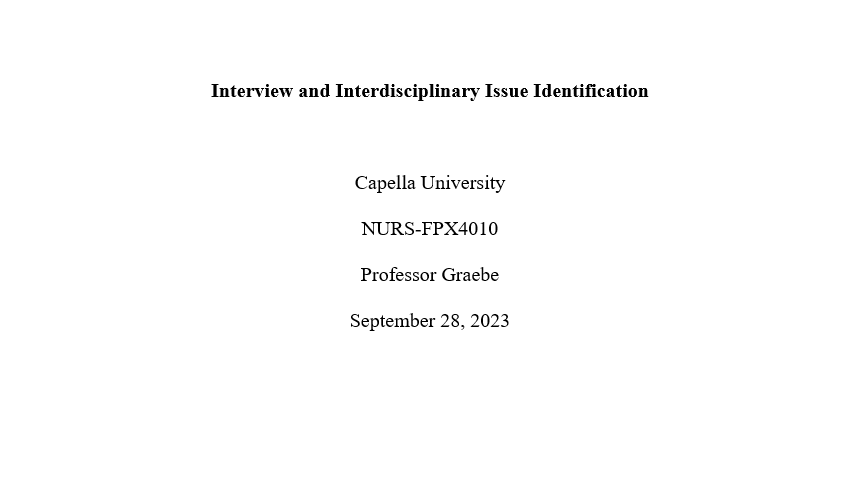NURS-FPX4010_R_Assessment2-1 solution.docx
Interview and Interdisciplinary Issue Identification
Capella University
NURS-FPX4010
Professor Graebe
September 28, 2023
Interview and Interdisciplinary Issue Identification
Interview Summary
For this assessment, I interviewed Lisa who is Registered Nurse at Chesapeake Regional hospital. She has been a nurse for the past 16 years and is currently working as a travel RN. Duties of this travel RN include all aspects of patient care including vitals, assessing, and monitoring patients, administer medications, conducting orders, and educating patients and families.
Furthermore, she often takes on the responsibility of charge nurse. With her multiple years of experience and commitment to providing the best possible patient care, Lisa is an asset to the nursing staff.
Lisa describes Chesapeake Regional Medical Center, CRMC, as a small, mom-and-pop feel hospital. Everyone knows everyone, and everyone treats one another as a family of healthcare professionals. When bringing up the topic of issues within the organization, Lisa notes that there are similar issues in many organizations that she has currently worked for, and that no healthcare situation is ever the perfect scenario.
Lisa states that the main issue has been nurse to patient staffing ratio. Even when there is an adequate amount of nursing staff, a nurse is often floated to another unit. Furthermore, healthcare techs have been short as well, leaving little room for support amid a shortage of nurses.
When asked to elaborate on how this effects her ability to perform tasks Lisa describes that when having a high nurse to patient ratio, work is usually done at a slower pace in that it takes longer to fulfill the basic tasks for each patient. Having to prioritize so closely makes it difficult to keep up and do the bare minimum. In addition, it makes for a higher chance of patient safety risks and lower customer service. Overall, while she feels each nurse can complete the duties, it has many negative results.
Lisa has been a travel RN at this organization for the past five months and in that time a new manger has come on board. The staff saw that as an opportunity to address this issue, among others. This was done by asking for meetings with management. Healthcare techs voiced their concerns as well. These meetings have brought up the conversation of retention for staff as a solution.
The results have been empty promises from management to cap ratios. Tech staffing has been addressed as more have been hired and trained, however, floating is an everyday thing leaving some units, as this one, short. On days when that is not possible, they have blocked off rooms. The result of that has been the next shift having an influx of admissions.
When asked about the organizations general attitude related to collaboration, Lisa again went to the family-oriented feel of the hospital. The organization promotes teamwork and provides opportunities for collaboration for example, through floating a nurse from one unit to one that is more short-staffed. Still, this does not take away the fact that everyone is spread thin regardless. Everyone stays positive and work towards the common goal of providing the highest level of patient centered care.
Issue Identification
The issue of staffing in nursing is a complex one and thus must be solved in a complex manner. Interdisciplinary communication and teamwork are vital in healthcare and topics such as these among others, can be applied to the short staffing in nursing. According to Lou, et al. (2020), “team-based care is believed to improve quality of care” (p. 113). Without interdisciplinary communication and collaboration, there cannot be team-based care.
Where staffing is concerned, interdisciplinary care is necessary to alleviate the stress felt by those on a team and provide support, mainly nurses in this case. Furthermore, nursing staff alone cannot solve the issue of short staffing. There are multiple levels to the nursing team alone, i.e staff nurses, nurse managers, executive nurses, who must work together to address shortages while conducting delivery of care (Lou, et al., 2020).
Even still, there is a shortage of nursing faculty along with an increasing need, so collaboration is necessary among not only nursing staff, but by improving communication among healthcare staff, distributing responsibility appropriately, and creating a team that works well to provide adequate care, despite shortcomings such as staffing (Perkins, 2021).
Change Theories That Could Lead to an Interdisciplinary Solution
Kurt Lewin’s change model can be used as an interdisciplinary solution to the issue of understaffing in nursing. According to the recent and peer reviewed article, The Origins of Lewin’s Three-Step Model of Change, this “has become the best-known and, arguably, the most influential approach to organizational change (Burnes, 2019).” Adding support staff and current workers in healthcare working together, is a solution to the nursing staffing shortage.
Lewin’s change model is an adaptive model that involves three stages including unfreezing, moving, and refreezing, and must draw on varied factors to be applied to an individual situation (Hussain, et al., 2017). The first stage in this change theory is unfreezing which focuses on making stakeholders aware of the issue and educating on the forces that effect the issue to facilitate detaching from the current order to make necessary changes.
Furthermore, this stage will make for less resistance to the change being implemented (Hussain, et. al, 2017). In pertinence to the staffing issue in nursing, there can be interdisciplinary solutions by educating all stakeholders, i.e all healthcare workers and up, in an organization on the issue, factors involved, and coming change.
The second phase of Lewin’s model is moving, which is when the implementation of actual change occurs. As discussed in the first stage, the staff should be educated at this point and understanding of the necessity for the change. Moving in this case would include a new sense of teamwork among all healthcare workers, management, and even executives, as well as providing more support to the team in the way of hiring up and out. By this would mean to include positions that would offer support in patient care.
Licensed practical nurses (LPN’s), volunteers, healthcare techs, and any profession that could help in the direct care of patients should be included. For example, though the scope of practice for an LPN is not exact to an RN’s, the amount within their scope of practice could heavily alleviate the amount an RN would need to manage in a short staffing situation (Perkins, 2021).
With a new level of understanding between disciplines as far as necessary teamwork and the implementation of support staff goes, short staffing in nursing could have a probable outcome apart from only relying on hiring more Registered Nurses.
The third stage of Lewin’s model is refreezing. This is the time when the changes will become the new normal for the organization as opposed to being a temporary situation. Positive reinforcement, and continued support are vital in this stage to not revert to the pre change climate.
Leadership Strategies that Could Lead to an Interdisciplinary Solution
Democratic leadership would be an effective approach leading to an interdisciplinary solution of staffing shortage in nursing. Democratic leadership is a style in which the leader allows the group to have an input of ideas and opinions, even though the leader will ultimately make the final decision (Crosby, 2020). This balanced style of leading often leads to high morale, high tension, and low conflict (Crosby, 2020).
A democratic leadership style is relevant because it allows for interdisciplinary communication. Through this nursing staff can relay to management what sort of support would best help when staffing is short and how communication and teamwork can be changed to be more effective. With the input, the nurse manager can make suitable recommendations to executives and others who have a final say in implementing the change.
Collaborative Approaches for Interdisciplinary Teams
In healthcare interdisciplinary collaboration is necessary to provide safe and effective patient care and improve outcomes (Yammamoto, 2022). There are diverse ways in which interdisciplinary teams can collaborate. One way in teams can collaborate is through interdisciplinary rounding. Interdisciplinary rounds are when healthcare workers from multiple disciplines such as physicians, nurses, therapists, and more, meet to discuss plans of care for patients (Beaird, et. al., 2019).
The results of these rounds can be increased communication and discussions on collaboration, both of which improve patient care and minimize lack of knowledge and extra work on another specialty. For example, if support staff, such as an LPN is present in rounding, an RN will not need to take on the responsibility of repeating plans and necessary actions for patient care. Furthermore, each team has an opportunity to tell how the other teams can help to establish good teamwork.
References
Beaird, G., Baernholdt, M., & White, K. R. (2020). Perceptions of interdisciplinary rounding practices. Journal of Clinical Nursing, 29(7-8), 1141–1150. https://doi.org/10.1111/jocn.15161
Burnes, B. (2019). The origins of lewin’s three-step model of change. The Journal of Applied Behavioral Science, 56(1), 32–59. https://doi.org/10.1177/0021886319892685
Crosby, G. (2020). Lewin’s democratic style of situational leadership: A fresh look at a powerful od model. The Journal of Applied Behavioral Science, 002188632097981. https://doi.org/10.1177/0021886320979810
Hussain, S., Lei, S., Akram, T., Haider, M., Hussain, S., & Ali, M. (2018). Kurt lewin’s change model: A critical review of the role of leadership and employee involvement in organizational change. Journal of Innovation & Knowledge, 3(3), 123–127. https://doi.org/10.1016/j.jik.2016.07.002
Luo, Q., Dor, A., & Pittman, P. (2020). Optimal staffing in community health centers to improve quality of care. Health Services Research, 56(1), 112–122. https://doi.org/10.1111/1475-6773.13566
Perkins, A. (2021). Nursing shortage. Nursing Made Incredibly Easy!, 19(5), 49–54. https://doi.org/10.1097/01.nme.0000767268.61806.d9
Yamamoto, K. (2022). Association between interdisciplinary collaboration and leadership ability in intensive care unit nurses: A cross-sectional study. Journal of Nursing Research, 30(2), e202. https://doi.org/10.1097/jnr.0000000000000483



